Early tomatoes. Superdeterminant Tomato Varieties
.
Varieties of bergamot.
Lime, limetta: varieties.
Citrus hybrids: varieties.
Oranges: varieties for the home.
Grapefruits: varieties for the home.
Gardeners gardeners
website, 2000-2017 - an online resource about home and family. ABOUT indoor plants, landscape design, soap making, permaculture, natural farming, about gardens, growing plants and flowers, about natural gemstones, quality home goods, good books. Personal experience people living outside the city, reviews and recommendations.
You can choose these varieties of tomatoes:
- Tomatoes for long-term storage
- Tomatoes for open ground
- Tomatoes for greenhouses, film shelters and open ground
- Tomatoes for greenhouses and film shelters
- Super Large Tomatoes
- Tomatoes-Super
- Cherry tomatoes
- Tomatoes - Miracle
- Tomatoes-Miracle for connoisseurs (for open ground and temporary shelters)
- Tomatoes-Miracle Raspberry
Growing conditions in greenhouses and open field are very different. In greenhouses, fever and humidity are high. As a rule, hybrids intended for open ground do not bear fruit in a greenhouse, greenhouse hybrids feel uncomfortable in open ground. However, there are exceptions. Some early ripe hybrids produce fruits equally well in greenhouses and in the open field.
Many gardeners in the Urals and Siberia almost stopped growing tomatoes in the open field. Greenhouse hybrids far exceed their street counterparts in terms of yield and size, but to taste ... There’s nothing to argue about. Street tastier. And to the one who waves his hand to these words, we answer. You need to know what to grow in the open field. Early and very early hybrids are needed. After all, there are already such hybrids that ripen simultaneously with the early greenhouse hybrids and thereby sharply increase the mass early harvest. Greenhouses are not rubber. And eaters who want to taste the early tomatoes, for some reason, always turns out to be much more than the tomatoes themselves. In this case, you are guaranteed to gain only the very early hybrids of open ground.
Examples of varieties:
Hybrid "Debut" Code 2013
Not the earliest and not the largest. But it is they who will reward you for quite modest labors with an absolutely incredible harvest. Powerful, thick branches bend under the weight of fruits, 6-7 kg from a bush, what more could you want! Record and Debut - these champions in yield. The fruits of Record are completely round, and in Debut they resemble giant plums.
Hybrid "ELENA" Code 2014
This is an all-weather tomato. Let summer be cold and rainy, let all summer sunny days be counted on fingers. And you look at Elena's bush, and your heart rejoices: a lot of pretty tomatoes blush in the bud. And the cold does not trouble him. This hybrid gives the whole harvest very amicably. From the bush you can at once collect up to half a bucket of excellent fruits. Masking is not required, landing scheme 60 * 50 cm.
Hybrid "ZEFIR" Code 2015
Ripen along with early tomatoes in the greenhouse. The sight is strange, unusual. The first ripe red fruits are located at the very top of the bush, above the leaves, shining and visible for a kilometer. Enchanted by this magical picture, the guests of your garden for a long time fall silent, and then all evening they are trying to figure out “from where” and “what you water”. Yes, we don’t water anything special. A hybrid of this, that's the whole secret. Bushes are low, compact. Zephyr fruit oval, tasty. Garauy's early fruits have a rounded-egg shape with a well-marked spout, as well as excellent taste.
Hybrid "ROBINZON" Code 2019
Need to sow before others. It is very unusual and interesting. Unlike all other varieties, its leaves are of potato type, the fruits are flat, crimson, up to 300 g in weight. With early sowing and good care gives a very high yield. From the fruits of this particular variety, the best tomato juice is obtained for lecho from pepper and tomatoes in its own juice.
Hybrid "SON OF HERO" Code 2020
More recently, we considered the Hero of the Early One of the earliest varieties of tomatoes. But selection does not stand still - our hero has a son. He took all the best from his father, and in some ways surpassed him. This is the earliest hybrid in our collection.
SOCHELNIK hybrid Code 2029
It begins to ripen somewhat earlier than the Blizzard, and is stored even longer.
The hybrids of the Cinch, Metelitsa, Christmas Eve and Vityaz form one or two stalks. We recommend forming the plants in one stem with the transfer of the growth point to an additional shoot (stepson) after the third (from the bottom, from the root) inflorescence. Passynok below the first inflorescence and before the third inflorescence is removed as early as possible. The peculiarity of these three hybrids is that they end their growth with inflorescences, and if you remove all stepchildren without a thought, you can remain without a growth point. Premature removal of the growth point limits the number of inflorescences. Therefore, after the third inflorescence (counting from the bottom, from the root), these hybrids should have a stepchild with a new growth point.
The planting of long-stored hybrids 60 * 60 cm.
Among the many diverse varieties of tomatoes, raspberry tomato is especially honored in Russia. Gentle, sweet, with fleshy, juicy watermelon flesh and attractive raspberry color, it is always an indispensable favorite in the vegetable market. Only the eye is immediately riveted on it and the hand involuntarily stretches, anticipating in advance the pleasure of enjoying exquisite, unique taste.
For twelve years we have been intensively engaged in the selection of raspberry tomatoes. A gigantic work was done, and finally, good luck smiled at us. Given the preferences of Russians, we offer a series of crimson hybrids, new products Crimson miracle. All of them are selected beauties - it’s kind of expensive to see: smooth, smooth, moderately dense and quite plump, weighing from 300-500 to 700 g, shining with wonderful berry shades of their favorite raspberry color and pleasantly surprising with an amazing, perfectly balanced, harmonious taste.
"The robins having heard the voice, I remember the forgotten dates ..." Hearing the words of this song, we again return to the distant 70s, where our barefoot childhood was, where our youth with first love and dancing was before dawn. All this was and all this will be. And our musical "crimson series" will remind you of those bright and beautiful years.
So below on the photo, see the pages of the catalog with a list of the best varieties of tomatoes.
Catalog of tomato seeds of the best varieties
Gardens of Russia, spring 2015, catalog of seeds.
List of seed catalog.
NGO Gardens of Russia.
Medals Top Seeds.
Hybrids of tomatoes for greenhouses and film shelters - a list of seeds.
Tomatoes under the film and for open ground, seeds.
The best varieties of tomatoes, descriptions and photos.
Tomato hybrids for long-term storage.
Extra large tomatoes.
Extra large tomatoes, hybrids, list.
Extra large tomatoes, varieties.
Miracle tomatoes.
varieties, tomatoesearly the choice, country councils, february, march, April, the garden and the beds February 11, 2014, 11:20
For our places, recognized as a zone of risk farming, the precocity of tomatoes is one of the important advantages. Both breeders and seed producers understand this.
It is not by chance that the number of early and ultra early varieties and hybrids of tomato (with the start of fruiting in less than 100 days after sowing) is growing every year. In general, we have already spoken about how to choose varieties of tomatoes - it's time to move on to specifics)) I suggest you review the earliest varieties and hybrids of this popular culture from various manufacturers (by the way, an overview of seed producers with the addresses of their online stores, if any, will help you to get the varieties you like, and to help those who have not bought seeds on the Internet - a useful article on how to do it right).
Early varieties of tomatoes for open ground
Alpha
Early ripening superdeterminant variety (87-96 days from germination to the beginning of fruit ripening) for open ground and film shelters. Can be grown in a seedless way. Plant height 40-50 cm.Fruits are medium-sized (50-70 g), flat-round, red, juicy. Appointment - salad.
Amur Shtamb
Early ripe determinant grade (85-95 days) for an open ground and film shelters. Can be grown in a seedless way.Plant 45-50 cm tall, standard, not requiring pasynkovaniya. Fruits weighing up to 120 g, rounded, red. Purpose varieties - salad. The variety is valuable for its cold resistance, resistance to adverse climatic conditions, undemanding.
Aphrodite F1
Ultra early determinant hybrid (75-80 days) for open ground. Plant 50-70 cm tall, compact. Fruits weighing 110-115 g, round, red, very dense, differ excellent keeping quality and transportability. Purpose - universal.
Benito F1
Ultra early determinant hybrid (fruiting begins 70 days after sowing) for open ground and film shelters. The plant is low (45-50 cm). Fruits up to 140 g in weight, plum-shaped, red, fleshy.Purpose - universal. The hybrid is resistant to Verticillium wilt and Fusarium.
Valentine
Early ripe determinant variety (95-98 days) for open ground. Differs drought tolerance, endurance, early friendly fruiting. Plant up to 70 cm tall, half sprawling, not needing to be staved.
Fruits weighing 80-120 g, plum-shaped, red, have a thick thick skin; resistant to cracking; they are elevated ascorbic acid. The purpose of the variety is universal.
Explosion
An improved version of the classic variety "White filling." Early ripe determinant variety (93-100 days) for open ground and film shelters. Can be grown in a seedless way. The plant is 40-45 cm tall, sprawling, requiring moderate coining.
Fruits weighing 120-150 g, round, red. Purpose - universal. The variety is characterized by high cold resistance, late blight resistance.
Gina
Early ripe determinant grade (90-100 days) for open ground and film greenhouses.The plant is up to 70 cm tall, it needs moderate staving. Fruits reach a weight of 300-350 g (average weight 190-210 g), rounded, orange-red, fleshy, resistant to cracking. The purpose of the variety is universal.
Stable in verticillary wilt and fusarium.
Don Juan
Early ripe determinant grade (90-100 days) for open ground and film shelters.Plant height 60-70 cm. The fruits have an original shape and color: they are elongated, with a “nose”; crimson, with thin longitudinal yellow stripes. Fruit weight 70-80 g; they are well transported and stored.
Far North
Early ripe determinant grade (85-93 days) for an open ground and film shelters.Can be grown in a seedless way. The plant is up to 65 cm in height, standard, not needing to stitch, compact. Fruits weighing 60-70 g, round, red. Purpose - universal.
The variety is notable for cold resistance, late blight resistance, friendly fruiting.
F1 Doll
Ultra early determinant hybrid (85-95 days) for open ground and film shelters. Differs in high productivity.The plant reaches 60-70 cm in height, requires moderate staving. Fruits weighing 150-200 g (can reach 400 g in good conditions), rounded, pink. It is recommended for the fresh use and processing.
Cupid F1
Early determinant hybrid (90 days) for open ground. Awarded the Gold Medal of the Gardener and Farmer Exhibition; differs in high productivity. The plant is up to 60 cm in height, it needs moderate pasynkovanii.Fruits weighing 75-100 g, flat-round, red, dense, differ in excellent transportability and increased keeping quality. Recommended for canning and commercial production.
F1 Legionnaire
Early determinant hybrid (90-95 days) for open ground and film shelters. The plant is low (45-60 cm), but sprawling. Fruits weighing 140-150 g, pink, rounded, do not crack.
Appointment - salad. The hybrid is notable for its increased resistance to a variety of diseases, including bacteriosis and late blight.
Maxim
Ultra early determinant variety (75-80 days) for open ground. The plant is low (50-60 cm).Fruits weighing 80-100 g, red, flat-round shape, good taste. The purpose of the variety is universal.
Marisha
Early ripe determinant variety (80-90 days) for open ground. A low (40-50 cm) plant does not need to be staved. Fruits weighing 50-120 g, round, red, are notable for good transportability. Purpose varieties - salad.
Parodist
New ultra-early determinant variety (80-85 days) for open ground and film greenhouses.A plant with a height of 40-50 cm when grown in open ground does not require a pinching and formation; when grown in film greenhouses, it is recommended to form 3 stalks, 3-4 brushes each. Fruits weighing 140-160 g, flat-round, red.
The grade is distinguished by a high setting of fruits in any weather conditions, productivity. Appointment - salad.
Sanka
Ultra-early determinant variety (85-96 days) for outdoor and film shelters. Plant 35-40 cm tall, compact, not needing to be putted. Fruits weighing 80-100 g, round, red.
The purpose of the variety is universal. The variety has a friendly ripening of the crop.
Early tomato varieties for greenhouses
Golden brush
Early maturing indeterminantny grade (95-98 days) for protected ground. A plant up to 150 cm tall needs a garter and pinching. Fruits are small (20-30 g), pear-shaped, golden-yellow, dense, excellent sweet taste; form beautiful large brushes.
The purpose of the variety is universal.
Mandarin
Early ripe indeterminate brush variety (90-100 days) for protected ground.The plant is vigorous, requires obligatory garter and staking; recommended formation in 1 stalk with pinching point growth at the end of the growing season. Fruits weighing 80-100 g, bright orange, in brushes (up to 10 pieces); have excellent taste.
The value of a variety is in its ability to tie fruit even in adverse conditions. Purpose - universal.
Greenhouse early F1
Ultra-early determinant hybrid (80-90 days) for protected ground. Plant up to 70 cm tall, half sprawling.Fruits weighing 120-180 g, rounded, red, dense. The purpose of the variety is universal.
Poznan
Early ripe indeterminate brush variety (95-100 days) for protected ground. Plant height 190-200 cm, garter and pasynkovanie required. Formation in 1 stalk is recommended.
Fruits weighing 80-120 g, round, orange-colored, form dense brushes. The purpose of the variety is universal.
F1 gift
Early ripe semi determinant hybrid (90-100 days) for protected ground and film shelters. Plant height 65-75 cm; requires composting Fruits weighing 120-170 g, round, red, leveled, dense, have a good keeping quality during storage.
Garter of tall tomatoes
Purpose - universal.
Raspberry Sugar Plum
Early mature semi-determinant variety (87-95 days) for protected ground.Plant height 102-140 cm; garter and pasynkovanie required. Fruits weighing 20-25 g, raspberry, plum-shaped, dense, have a sweet taste and a high content of vitamins, tolerate transportation. The purpose of the variety is universal.
Sweet bunch
Early ripe indeterminantny grade (90-100 days) for the protected soil. Plant height of 2.5 m or more; needs compulsory garter and pasynkovanii, as well as the formation (in 2 stalks).Fruits weighing 10-20 g, red, round, sweet; form a brush of 20-50 fruits. Purpose - universal. The variety is consistently harvested even in adverse conditions, it is characterized by long and very abundant fruiting.
Superstar
Ultra short-term semi-determinant variety (85-90 days) for protected ground and film covers. Plant height 100-140 cm; pasynkovanie required. Fruits are large (200-250 g), fleshy, red, rounded flat, sweet taste. Appointment - salad.
Meal
Early maturing indeterminantny grade (85-95 days) for protected ground and film shelters. The plant reaches a height of 150-180 cm and requires a pinching and garter. Fruits are medium-sized (17-20 g), oblong-oval, red, dense, of excellent taste.
Varieties of tomatoes (continued) .avi
Early tomato varieties for balconies and home garden
Room surprise
Ultra early determinant variety (80-90 days) for compacted plantings in open ground, cultivated in container crops on balconies, loggias and at home.Plant up to 50 cm, compact, does not require formation. Fruits weighing up to 60 g, plum-shaped, red. Fruiting friendly and abundant. The purpose of the variety is universal.
Minibel
Early determinant variety (89-96 days) for cultivation in the open field and under the film shelters, as well as on loggias, balconies and at home. The plant is compact, 30-40 cm tall, does not require staving.
Differs in plentiful fructification; fruits are small (15-25 g), red, pleasant sweet taste with a slight sourness. Purpose - universal.
The variety is particularly noteworthy undemanding, the ability to bear fruit well in low light and high decorative.
Room Pygmy
Early ripe determinant variety (80-87 days) for open ground.It can be grown up as a pot culture on terraces, balconies, loggias; used for home vegetable growing; land in compacted vegetable and flower plantings (in borders). The plant is 25-30 cm tall, standard, does not require staging.
Can be grown in a seedless way. Abundant fructification. Fruits weighing about 25 g, red, round, very sweet. The purpose of the variety is universal.
Pinocchio
Early determinant variety (90-95 days) for balconies, loggias, growing at home. It can be used for sealed landings.The plant is undersized (20-30 cm), standard, compact, does not require staking. Fruits weighing 15-20 g, rounded. The variety is remarkable for its decorative and yield.
Purpose - universal.
Garden Pearl
Ultra early determinant variety (89-93 days) for open ground, balconies, loggias and cultivation at home (on the windowsill).Plant 30-40 cm tall, creeping; does not need to be staved; very decorative, especially during the fruiting period. Fruiting is very abundant (up to 300-400 fruits per season). Fruits are small (15-20 g), pink.
The purpose of the variety is universal. It can be grown, including, in flower beds as an ornamental plant.
Snegirek
Ultra-fast superdeterminant variety (80-90 days) for open ground, balconies and home vegetable growing.Can be grown in a seedless way. Plant height 25-30 cm; pasynkovanie and formation is not required. Fruits weighing 20-25 g, red, very sweet.
Purpose - universal. Of course, this review is far from exhausting the entire abundance of early varieties of tomatoes on the market today.
I hope you, friends, will add it to the descriptions of the varieties that you grow in your garden or balcony. A tomato, or a tomato, is a heat-loving and light-loving plant. However, the optimum temperature for growing tomatoes may vary slightly depending on their variety.
For example, all the northern varieties are much more cold-resistant than the southern ones. The scheme of suitability of tomato seedlings. For each specific condition, it is necessary to select the desired temperature regime for the soil and air. The higher the temperature regime is maintained, the faster the ripening occurs, the inflorescence is less ramified, but at the same time the fruits are smaller and the cells in them are smaller.
Interno-sites, as a rule, are also significantly longer, and, in general, this leads to a low but early harvest. While maintaining lower temperatures, the harvest is later but abundant. It is necessary to choose tomatoes for cultivation, based on their need for heat and light, taking into account the terms of fruiting.
Tomatoes are distinguished by the structure of the bush on the standard, non-standard and potato-shaped
- The stem bush is distinguished by strong and dense stems and branches. Compared to other species, the leaves of such tomatoes are smaller, more corrugated and have thin petioles. The advantages of such a bush can be considered its compactness. These include dwarf and superdeterminant varieties. Such bushes are preferred for early harvest. These varieties are mostly undemanding to the vagaries of the weather. The neshtambovy shrub has thin stems that lie during the fruiting period. The leaves, as a rule, are large and practically not corrugated. To avoid lodging, such bushes need to be tied up to supports as early as possible. Such tomatoes are more demanding to comply with the temperature and worse tolerate cold weather. Potato bush can be found infrequently. It got its name because of the strong similarity between the leaves and the potato ones. These tomatoes are often late-ripening and cold-resistant.
It is also possible to divide tomatoes into several separate varieties, depending on the height of the bush.
There are determinant, superdeterminant and semi-determinant varieties.
Scheme pruning overgrown seedlings.
- Low and poorly branching varieties are called determinant. The number of brushes they form is from 2 to 7, after which the stem completely ceases to grow, and side shoots do not grow further. These varieties have many positive qualities, in particular, they do not require pasynkovaniya and in the open field of the middle band well ripen. In the greenhouse, these varieties of tomatoes are guaranteed great harvestSuperdeterminant varieties stop growing after 2-3 brushes are formed on a bush. They can also be attributed to unpretentious varietiessuitable for outdoor use. Grown in a greenhouse with respect optimal conditions, they will certainly give high yields. Semi-determinant varieties on one stem can form 8-10 brushes. These varieties include various hybrids, tall and strongly branched. Although they grow about 2 meters in height, they bear fruit at a lower rate than other varieties. They require cradling and garters, as they form a lot of stepchildren. These varieties are ideal for greenhouses.
Back to table of contents
General temperature requirements for growing tomatoes
Temperatures above 25? begins to adversely affect photosynthesis. In cloudy weather, the temperature regime is maintained at 20–22? afternoon and 16 - 18? at night. When the illumination of the greenhouse is generally low, namely in the winter and early spring months at daytime of 17-20?, with completely overcast weather, you can stop at around 17 ?, and at night it is possible to decrease to 15 ?. After the tomatoes have cotyledons and the first real leaves, it is recommended to lower the temperature to 20 - 22? afternoon and 16 - 18? at night. This is the optimum temperature for the development of the first inflorescences.
When the first inflorescences form on the bush, does the daytime temperature drop to 17-18? in the daytime, and nighttime is maintained at around 16.? If the temperature drops below 15 ?, the tomatoes stop blooming, and in the case when it drops below 10?, their growth stops. Already at -1? most varieties die.http: //www.youtube.com/watch? v = xcmtIHfEyuI The increased temperature also affects not the best way on the cultivation of tomatoes.
Already at a temperature exceeding 30? in tomatoes, the normal course of physiological processes is disturbed, including sterile pollen, and flowers often fall off. Burns on the fruit causes a temperature increase of more than 34?. The need to observe the temperature regime causes the difference between day and night temperatures in the greenhouse.
The difference should be more than 5?, This is due to the fact that the tomato needs to reduce the consumption of substances for breathing during the night. Especially important is the observance of this condition in the period of growth and ripening of fruits. Soil temperature has a great influence on all vital processes.
In the root system, the synthesis of substances that are necessary for the growth and development of the plant occurs, and it stops at a temperature below 14 °. Such temperature cannot provide normal growth and fruition in any degree of illumination. Http: //www.youtube.com/watch? V = pZAVnCgu9Dc The sum of all active temperatures (exceeding 10? C) before the beginning of the ripening period of fruits should be at least 1800 - 2000 ?
WITH.With proper hardening of tomatoes, starting from seedlings, bushes can withstand short-term cooling to 0? Without special losses, but the effect of negative temperatures on tomatoes cannot be reduced. By growing open field tomatoes, you can get good yields, but much larger yields can be obtained by doing growing tomatoes in a greenhouse. If the yield of tomatoes in an open area averages 300-500 kg per weave, then in the greenhouse you can get a much larger crop: 1000-1500 kg per hundred protected ground is far from the limit.
Of course, the cost of tomatoes grown in this way will be more - about 10 times. Before you start growing tomatoes in a greenhouse, you need to decide on the variety. All types and varieties of tomatoes are divided into determinant and indeterminant.
Determinant - These are low-growing varieties. They are early ripening, but yield less yield. Indeterminate - tall varieties. Not so early, but the harvest they have more.
In the south and in greenhouses, it makes sense to grow indeterminate varieties, in the north - determinant varieties, in which in a short season they manage to ripen the crop.
Determinant Tomato Varieties
Determinant, or undersized, varieties stop the growth of shoots after a certain amount appears on them, as a rule, 4-5 hands. The main advantage of determinant varieties is the ability to produce an early harvest.
To get it, the plants are stepson, that is, they remove extra side shoots, otherwise many fruits will turn out, and their ripening time will be delayed. In these varieties, the first brush is tied after 5-7 leaves, and then the brushes are formed every 2 leaves. The determinant varieties of tomatoes are well suited for open ground in the south and in middle lane.
In the northern regions, these varieties can be grown in greenhouses. To prevent the shoots from lying on the ground, tomatoes of determinantal varieties are tied up.
Superdeterminant Tomato Varieties
The fastest growing early variety of determinant tomato varieties. This is very early varietieswhich do not require staking at all.
Standard Tomatoes
Varieties of tomatoes that do not need to tie up. Also, they do not need to form. Their features - the lowest growth of shoots, and sturdy stem.
They belong to the determinant varieties, and very early, as well as super determinant varieties. In shtambovy and superdeterminant varieties, the first brush is knotted after 4-5 true leaves, and then new brushes are knotted after 1-2 leaves.
Semi-determinant tomato varieties
Something in between indeterminate and determinantal varieties. Growth shoots of these varieties may end at the most unexpected moment. Usually they are formed in 2 shoots.
Indeterminate Tomato Varieties
Indeterminate, or tall, varieties have the property of unlimited growth of the main shoot. In greenhouses with heating and in warm countries, they can grow a year or more, giving 50 or more brushes of the crop. They are usually led in one stalk, stepson extra shoots.
In the south, these varieties can be grown on open ground and in greenhouses. In the middle lane, such varieties are grown in greenhouses, and in the north, such varieties will not work at all, because the harvest simply does not have time to ripen. The first brush of indeterminant varieties is tied, as a rule, after 9–12 true leaves, and then the brushes are laid every 2 leaves.
Features of growing tomatoes in the greenhouse
In greenhouses, as a rule, the air humidity is quite high, and there are large fluctuations in temperature during the day and at night. During the day, even overheating of plants is possible. Above also the occurrence of diseases, and spoilage of various pests.
That is why preference should be given to hybrid varieties - they are more resistant to diseases. First, the best grow seedlings, and then plant the seedlings in greenhouses. Do not keep the seedlings in pots for more than 50 days. Then plant the seedlings.
An important condition - do not plant seedlings in cold soil. If the temperature is set at 20-25 degrees in the daytime, and at night - not less than 8-10 degrees - then tomatoes can be planted in a permanent place.
For normal plant development, not even air temperature is more important, but soil temperature. You can check the temperature - take a thermometer, and measure the temperature of the soil at a depth of 15 cm. If the temperature is more than 15 degrees, then everything is fine.
If less - it is worth the wait with the seedlings. To warm up the soil, it is necessary to pre-install a greenhouse, and close all its openings.
Temperature and humidity
It should be borne in mind that tomatoes do not like either too high or too low temperature. During the flowering period, a temperature of more than 35 degrees, or less than 12 degrees, in combination with high humidity, leads to the fact that the flowers are not pollinated.
In this case, you can be left without a harvest. Large humidity of air is generally contraindicated for tomatoes, unlike cucumbers, for example, and therefore it is not necessary to grow cucumbers and tomatoes in one greenhouse. In order not to have high humidity in the greenhouse, they need to be ventilated in the summer, better open up. In the spring and autumn, on the contrary, we close all the openings of the greenhouse so that the temperature is higher - tomatoes, after all, are heat-loving plants.
The soil
Tomatoes - a culture very demanding on soil fertility. Regularly under the bushes need to throw organics, humus, rotted manure. Do not forget also about top dressing.
It is not worth growing tomatoes in one place all the time - diseases accumulate in the ground. It is necessary to alternate cultures. Tomatoes are best planted after legumes, cucumbers, onions and carrots. Plant after all the nightshade, namely, potatoes, peppers, eggplant is not worth it.
After tomatoes, they should be grown in the same area no earlier than in 3-4 years. You can get more detailed information in the "All Courses" and "Utility" sections, which can be accessed through the top menu of the site. In these sections, articles are grouped by subject in blocks containing the most detailed (as far as possible) information on various topics.
You can also subscribe to the blog, and learn about all the new articles. It does not take much time. Just click the link below:
Autumn and winter does not mean at all that our summer troubles are over. In the calibration of the day, the vegetable gardener has already put the main question: what kind of tomatoes to plant in 2016? Which cucumbers to choose in next year for landing? What time is it worth sowing pepper next spring? And is it worth next year to grow cabbage with seedlings? Let us try to answer one of these questions, which concerns planting tomatoes (tomatoes).
Interesting varieties of tomatoes can be found in the list of seeds offered to us, which can be bought both in specialized stores and online stores. Choose the best varieties of tomatoes for greenhouses is very difficult, given the abundance of varieties and hybrids that are sold in stores. When buying tomato seeds, you need to consider:
- yield,
- frost resistance
- susceptibility to diseases
- taste and climatic conditions.
To facilitate the choice - what varieties of tomatoes for greenhouses to choose, we give a recommendation from an experienced gardener:
“In my greenhouse I grow, of course, mostly indites. Varieties of all colors and flavors, for salads, for kids (cherry tomatoes, of course) and for pickling juices. I will not advise on varieties - all is one - the year is not necessary for a year. And I would advise you to stick in the foreground a few early ripening undersized bushes - tomatoes will be before open ground and before Indians in the greenhouse. "
Indeterminate Tomatoes
Tomatoes indents — these are indeterminate tomatoes, tomatoes that are constantly growing. They are tall and their stem growth is unlimited. The first inflorescence on such tomatoes is formed after the seventh-twelfth leaf, the next every three leaves. Indeterminate varieties and tomato hybrids are the best tomato varieties for greenhouses in 2016, as they grow steadily and bear fruit until late autumn.
There are many hybrids and varieties, the earliest hybrid F1 F1 Eupator C5F2N. Suitable for both film greenhouses and glazed. Its fruits are rounded, with an ideally smooth surface, weighing 140–160 g, of intense red color with high taste. The hybrid is genetically resistant to cracking and apical rot of fruits, cladosporia, fusarium and gall nematodes.
The main thing is to understand what interests us in the tomatoes that we are going to grow. Maybe it is the color of the vegetable? Now you can buy seeds of yellow tomato ("Date Yellow", "Firebird", "Amber Cup", "Dragon Heart", "Golden Fish"), white ("Lotos", "White Sugar", "Snow White", " White Snow "), as well as purple (" Dance with the Smurfs "," Blueberries "," Black Cluster "), orange (" Persimmon "," Wonder of the World "," Orange Heart "," Golden Fleece ") and even black ( "Ethiop", "Indigo Rose") tomatoes.
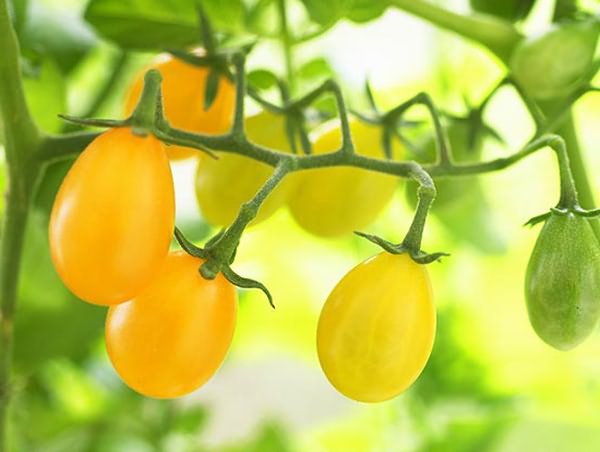
And perhaps we are primarily interested in the size of the fetus. Tomato can be a real giant in favorable growing conditions. But maybe we will be interested in a medium-sized tomato, which by its “ideal forms” is more like a work of art than a vegetable for canning (it is more convenient to put these varieties in the bottle).
For example, I really like the varieties of small cherry tomatoes, which cause emotion when you see them on a bush. Fertility of a shrub or high-low height of a plant, as well as resistance of a variety to diseases, can also become a search criterion. And perhaps early greenhouse varieties of tomato that can be grown in a greenhouse will be interesting.
Tomatoes early for film greenhouses and hotbeds 2016. Which tomatoes to plant in the new season.
The best early tomatoes are often indeterminate (the growth of the main stem in which does not stop). They are tall types of tomatoes, which is a convenience when growing in small areas. Here are some of them:
- "Sprinter F1". One of the most early hybrids. Fruits of red color round-flat, weighing 150-200 grams.
- "Kronos F1". Red dense fruits weighing 130-180 grams. One of the most recommended hybrids for film greenhouses.
- "Samurai F1" pink. Rounded slightly flattened fruit, about 200 grams in size. pink color has excellent keeping quality and good taste.
- "Pisa F1". Fruits plum-shaped red, collected in brushes. Mass of one tomato 90-120 gr. The ripening of fruits of one brush is almost simultaneous.
- "Swallowtail F1". Round pink fruits have an attractive appearance and good taste. Fruit weight 180-210 gr.
Large-fruited tomato varieties for greenhouses
If you are interested in growing high-yielding large-fruited tomatoes (beef-tomatoes) that have good taste and “fleshy” pulp, but are not intended for canning, pay attention to such time-tested and new varieties of tomatoes for greenhouses as:
- "Grandma's Secret." Fruits of crimson-red color, reach up to 1000 gr. weights, very tasty.
- "King of the Giants." Fruits are red, flat-round, 600-1000 gr.
- "Bull's Heart" (pink). Fruits are pink in color, sizes on the lower inflorescences reach 900-1000 gr., On inflorescences higher - 200-400 gr. The variety has a high taste.
- "Gardener". Red fleshy fruit, round, weighing up to 400 grams. Salad variety.
- "Orange". Round, orange fruit, resembling an orange, reaches a weight of 400 grams.
- "Mazarin." The fruit is heart-shaped, red-crimson color. Reaches weight 600 gr. Sweet salad variety.
- "Scorpio". Fruits weighing up to 800 grams. may be pink or crimson, depending on the lighting in the greenhouse.
Large fruit high-yielding varieties tomatoes for low greenhouses:
- Igranda - an early variety, resistant to weather changes, gives a bountiful harvest,
- Beef - mid-season variety with red fleshy fruits, weighing 200 grams,
- resource hybrid - long fruiting, has fruits weighing 150 grams,
- large-fruited hybrid Russian troika - gives fruits weighing 200 grams with a plant height of 50 - 60 cm,
- hybrid Major - a low shrub capable of producing fruits weighing up to 300 grams.
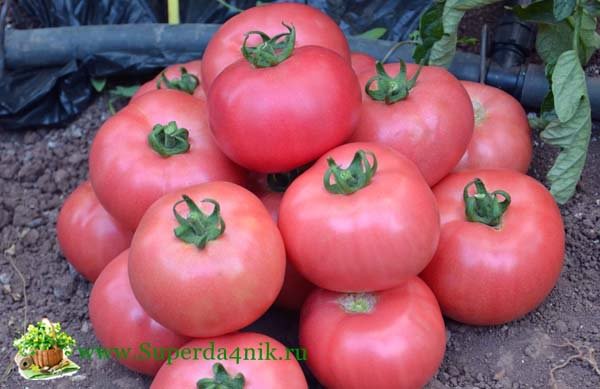
Mid-season grade Beef
Tall tomatoes for greenhouses
Tall tomatoes are good because: firstly, many of them are early in ripening; secondly, they occupy less space in the greenhouse, but at the same time have more inflorescences on the bush, and hence higher yields than those of low-growing varieties; thirdly, they bear fruit until late autumn, which again increases the amount of the harvested crop. Among tall come across such interesting varieties of tomatoes as:
- "Watermelon". The lash reaches two meters in length. Fruits 90-110 gr. on average, they have a red color with not pronounced stripes, similar to watermelon stripes. The shape of the fruit can be round and rounded flat.
- The Scarlet Mustang. The plant grows no more than 2 meters. Fruits of red color resemble rather a small cucumber or red pepper, i.e. have an elongated shape up to 25 cm. The weight of the fruit reaches 200 or more grams.
- "Verlioka F1". Grow up to 2 meters or more. Fruits have a rounded slightly ribbed surface, reach a weight of 60-90 grams.
- De Barao. This amazing type of tomato has a lot of colors - red, pink, yellow, black, striped. Scourge plants are usually more than 2 meters. Fruits in the form of "cream" weighing 50-100 grams. on average - 80 grams.
- "Sweet Cherry F1". Reaches a height of 4 meters. The red fruits look like a ping-pong ball, one brush can contain more than 20 tomatoes. Delicious fruits and a decorative type of a bunch distinguish this variety of tomato and attract the attention of summer residents.
We hope our advice helped you to choose from a variety of varieties of tomatoes, and plan which tomatoes for 2016 you would like to see on your site.
New varieties of tomatoes for 2016 for high greenhouses:
- Hybrid Semko - disease resistant, early ripe, with fleshy, sweet fruits of 200-400 grams,
- Semko -18,
- productive F1 hybrids Biggie and Juggler,
- varieties of the Siberian series Velzhmozha - pink large fruits, Sedek seed production,
- Pink king - tall, for salads, with fruits 300 g, crimson color,
- tomato Tyutchev - red fruits weighing 400 - 500 gr.
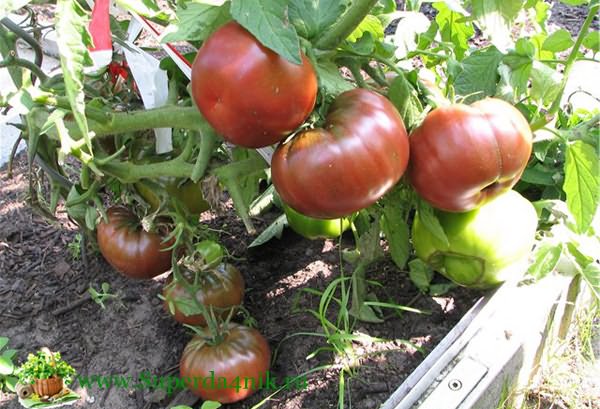
Tomatoes "Black Prince"
Interesting varieties of tomatoes for growing in garden greenhouses.
Large-fruited low-growing tomatoes, suitable for growing in low greenhouses and mini-hotbeds in the country:
- Paradise - greenhouse tomatoes, height 1.2 m, high-yielding: 6-8 large tomatoes ripen in each brush, weighing up to 200g,
- Raja - short, early, dark red, large-fruited (up to 300 g),
- hermitage variety is suitable for growing in the North-West region, early, abundant variety, fruit weight 100 g,
- Igranda and Pavlovskaya rose - early abundant varieties resistant to sudden changes in weather.
Small-fruited undersized fruit varieties of tomatoes, suitable for growing in low greenhouses:
- The skorokhod is only 50 cm tall, therefore it is ideal for growing in low greenhouses, it is plentiful and unpretentious,
- Biotechnics offers good tomato varieties for growing in modern polycarbonate greenhouses - this is lollipop, emerald gem, non-sautéing - 105, raisin,
- The company "Search" - Yellow delicacy (non-packaged greenhouse variety with fleshy fruits), Picket (Siberian series, non-storing, short, with elongated fruits up to 60 grams, bright red).
- tomato Sanka production Falita - ultra early, ultra determinant (fruiting on the stepsons, dense red fruits 80-100 gr (agrofirm Aelita).
It is believed that small-fruited low-growing tomatoes for low greenhouses are characterized by the fact that they do not need to be formed and grazed. In part, this is true, all small-fruited, undersized tomatoes are varieties of tomatoes without pasynkovaniya. They can be planted in an unheated greenhouse, closer to a tall one. Wait until the early varieties give up their crop and remove them. However, to increase yields, it is better to stepchild them. (How to pinch low-growing tomatoes)
Cherry tomato varieties for greenhouses and greenhouses
Cherry varieties and hybrids are tomatoes with small fruits, weighing no more than 25 g. Their peculiarity is that they are very sweet and tasty. Usually, these are precocious and tall tomatoes. On one brush can form on average from 16 to 20 fruits.
The color of tomatoes can be different - yellow, pink, red, orange, green and the shape is round, elongated, drop-shaped. Such multi-colored clusters of tomatoes are a beautiful decoration of the garden. They can be grown on balconies, in flowerpots and even in hanging pots.

Cherry tomatoes
You can choose cherry cherry cherry varieties:
- Minibel
- Cherry cherry tomato F1 Cherry
- Bonsai
- Red Cherry and Yellow Cherry
- F1 Golden Bead
- F1 Marishka
- F1 Zelenushka
superda4nik.ru
The best varieties of tomatoes for open ground are the most delicious and large-fruited.
The most large-fruited varieties and their detailed characteristics
For many gardeners, the size of the grown vegetable matters. They have an excellent appearance for trading on the market, they can boast to a neighbor or simply serve as a decoration. Their taste qualities, as a rule, are a little inferior to small fruits, but to grow a pair of bushes of such vegetables will not prevent every summer resident. To your attention the most large-fruited varieties of tomatoes for open ground and their detailed descriptions.
- Pudovik. Powerful. Tall bush (up to 150 cm), on which up to a dozen fruits weighing from 200 g to 1 kg are formed. Tomato Pudovik considered one of the largest in Russia, it is grown in almost all regions, even in the north. Period to technical ripeness - 115 days, is considered to be medium. The yield is 5 kg from one bush or up to 17 kg with 1m2. With good fertilizing with mineral fertilizers, the plant's immunity becomes much stronger.
- Tolstoy. Can not be considered best tomatoes for open ground and not to mention from this hybrid, which for 25 years of its existence on the Russian market has become a bestseller, as well as the variety Budenovka. His predecessor was the tomato variety. Tolstoy, which is known to all summer residents for 20 years at least. The average fruit weight is 230 grams, which is a good indicator. In addition to the large size, tomato Tolstoy F1 has another significant advantage - high yield. Gather 12 kg / 1 sq.m. It is not a record, it is quite possible to get on the usual dacha. Bushes grow up to 120 centimeters, sprawling, pasynkovanie not required. Ripening period - 150 days. Tomato Tolstoy It has a high resistance to many diseases, including powdery mildew and fusarium wilt.
- Tomato Bull heart This is one of the most famous "heavyweights", which has an excellent appearance, good taste and weight up to 900 g. Average fruits are not more than 300 g, while the first inflorescences give very large tomatoes, and those that ripen a little later can reach only 100-150 g. Has a great decorative look - heart shape. Sprawling bushes, upright, powerful, up to 130 centimeters. Tomatoes Bull heart are in great demand among summer residents who grow vegetables for themselves.
Remember that large fruits do not always mean high yields. As a rule, these are more ornamental vegetables for home and garden, which have no industrial value. If you seriously decide to engage in vegetable production, then you would be best to choose a hybrid that gives up to 12-20kg per square meter.

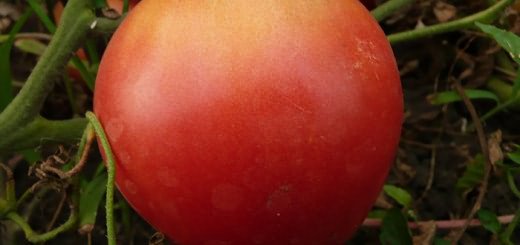

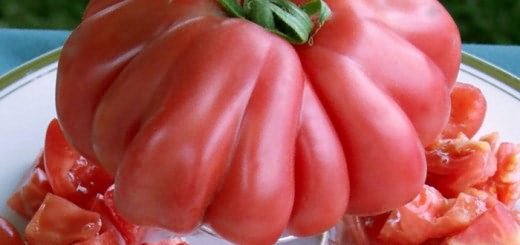

The most productive varieties and their descriptions
Today, there is high competition in the field of vegetable production, so the business must be extremely profitable. Tomato varieties dutch selection and some Russian analogues are capable of producing up to 20 kg per square meter, thereby significantly increasing the profitability of vegetable production. Fruits are small, but there are many, due to this, a high yield is obtained. Your attention the most "brightest" representatives of this category and description.
- Tomato Diabolic. The yield reaches 700 centners per hectare when grown in a selection plot, in under usual conditions, it is possible to produce 400-450 centners / ha with timely fertilization with minerals. Bushes are not sprawling, up to 120 centimeters in height, the fruits have a weight of 120-140 grams, the correct form. It has increased ease, well transported over long distances. Suitable for salting, fresh consumption, seaming and for other purposes. Resistance to diseases of the tomato is very high, especially to fusarium wilt, anthracosis of fruits and leaves, spot brown, white. It is much better than the best Dutch tomato varieties that are not acclimatized in the territory of the Russian Federation.
- Tomato Bobcat F1. Well-known hybrid, which gives quite good yields (40-50 tons per hectare). Fruits are relatively small, up to 140 g, well transported, lie well. Shrubs grow up to 120 centimeters in height, it is advisable to make a pinching so that there are more lateral layers as possible - the yield increases by about 21-24%. Resistance to anthracosis of leaves and fruits is high, almost not subject to fusarium wilt.
- Tomato Solokha. Large-fruited and high-yielding variety. The bush grows up to 90 centimeters in height, slightly sprawling. Tomatoes grow to an average of 150 grams, sometimes reaching 220-250 grams, especially if the load on the bush was small, up to two dozen fruits. The average yield - 450 centners, sometimes you can get more if you use drip irrigation.
The taste qualities of hybrids often leave much to be desired, since the content of sugar and ascorbic acid in them is minimal. Please note that the aromatic smell should not be expected from extremely productive varieties, since all their forces are focused on obtaining a certain tonnage.
If you grow for sale and subsequent sale, then this group of vegetables will be optimal for you. In case you want to get tasty, fragrant vegetables on your table, it will be better to give preference to ordinary Russian varieties that have a large amount of vitamin C, sucrose.
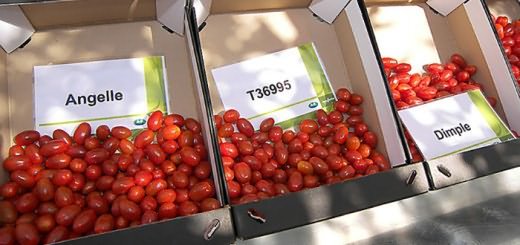
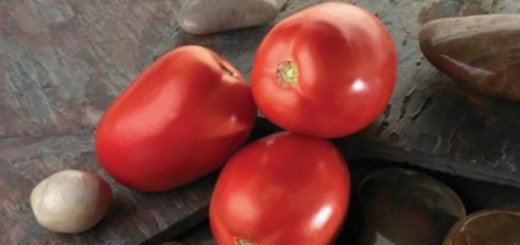
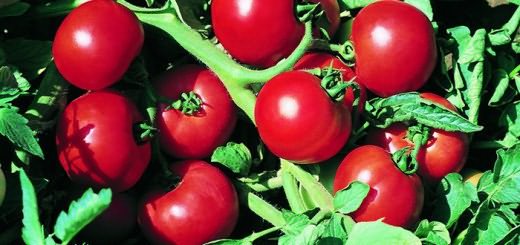

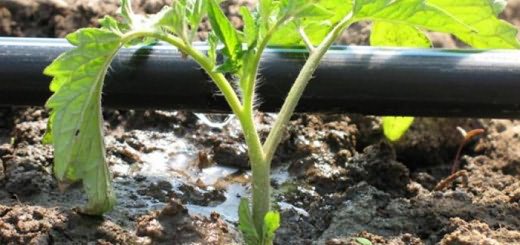
The most resistant tomatoes to disease and weather conditions
Residents of many areas are trying to find varieties that have solid immunity against pests, fungi, as well as high resistance to a sharp drop in temperature. First of all, these are areas of Siberia, as well as other northern areas where there is high humidity and rather low temperatures in spring. Consider now that it would be better to plant in such conditions.
- Tomato Marmande. This is one of the most resistant vegetables, which is almost not exposed to fungal diseases, can withstand the attacks of many pests. Moreover, the weight of the fetus reaches 250 g, which is quite a lot for this group. One of the most significant advantages of the plant is its resistance to rapid temperature changes, so the seedlings can be planted much earlier than usual, for about 2 weeks.
- Tomato Stellate sturgeon. By and large, this is the same Pudovik, only adapted to the conditions of the northern regions. Tomatoes are Dutch breeding, but then they were acclimatized in the Volga region and soon began to spread even in Siberia. The weight of one fruit is 450 grams, sometimes more, the skin is firm, the pulp is dense, well transported, it lasts a long time. Bush 140 cm high, pasynkovanie is not required, the stems are strong, grow without a garter. It grows well in a humid environment, the fungus does not attack.
- Tomato Roma. It is considered one of the most high-yielding hybrids growing in Russia, but besides the fact that it gives 60-70 tons per hectare, it is also extremely resistant to fungal diseases of all types. It does not undergo fusarium wilt, responds well to temperature changes. The term of ripening is 120 days, and the last few weeks can stand even with frost. Fruit weight does not exceed 140 grams, yield 25 tons per hectare, bush height of 120 centimeters, pasynkovanie necessary.
These were “extreme varieties” that can survive in almost any conditions. They ideally combine yield, mass of fruits, as well as resistance to various pests and diseases. That is why they are in extreme demand.
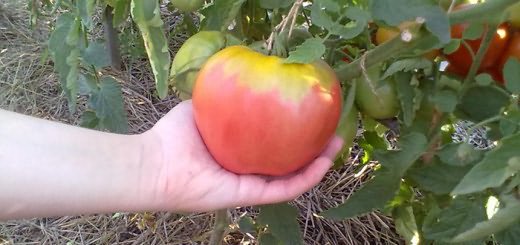
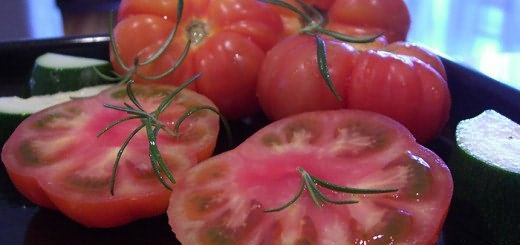
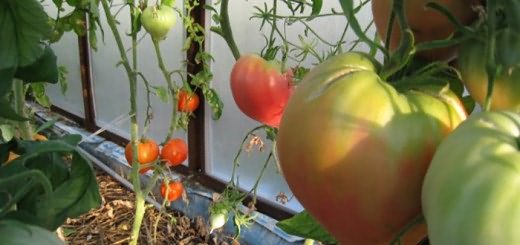
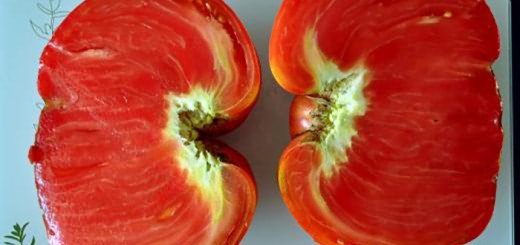
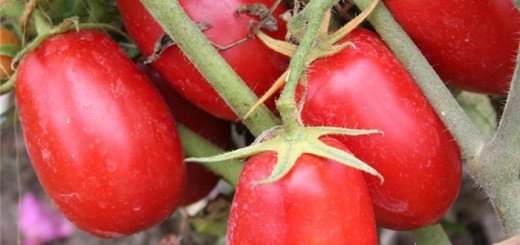

grounde.ru
The best varieties of tomatoes for greenhouses

The best varieties of tomatoes for growing in the greenhouseSelect the right grade Tomatoes for greenhouses can not every summer resident, and the reason for this is clear - lack of knowledge and professionalism. To correct the situation and help you grow a high-quality crop, today we will look at the best varieties of tomatoes for greenhouses.
Growing tomatoes in greenhouses - it’s quite a usual thing, but for those people who have been involved in tomatoes for years and know everything about them. For beginners who have just built a greenhouse and are preparing it for growing diverse crops, this topic can be quite complex. And, therefore, today we decided to consider the most popular and best varieties of tomatoes for greenhouses, according to many experts.
Thanks to the research of breeders and the observation of summer residents, the following list was compiled, which we hope will help you grow an excellent crop of sweet and juicy fruits:
Honey Drop Tomato
This variety has an excellent, bulk type and high sugar content. Each fruit of a medium-early tomato reaches a mass of up to 30 g. A seedling of this variety is planted in the middle of March, to a depth of several centimeters. The best temperature for growing tomatoes is the limit from +20 to + 25 ° С. Planting of seedlings in the ground occurs at the end of May, according to the scheme 70x40 cm. This variety does not require special careThe main thing is not to forget about systematic watering of tomatoes, weeding in rows, and loosening the soil after watering. Also, be sure to feed in the soil, which regulate the yield. In the first half of September, you will be able to collect beautiful and very tasty tomatoes;

Samara Tomato
One of the varieties of tomatoes, which is not only grown in greenhouses, but it is recommended for growing in closed ground. "Samara" - tomatoes with unlimited growth, group of wrist, large-sized fruit, juicy and sweet. Sowing of seeds of this variety is desirable in early March, dive standardly, in the phase of the first true leaf, be sure to finish exposure while growing seedlings. AT greenhouse soil seedlings are transported after 45-50 days, at the end of April, planted according to the 60x40 cm scheme. Now, after the seedlings hit the greenhouse, dosvet is also recommended, as well as a clothespin during flowering (you must leave no more than 4-5 flowers in the inflorescence). "Samara" is distinguished by round and smooth fruits, up to 80-90 g. Mature fruits are excellent for eating raw, as well as for canning;
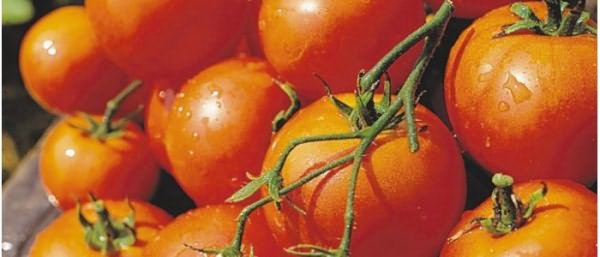
"Samara" - tomatoes with unlimited growth, group of carotid, large-sized fruit, juicy and sweet
Tomato "Moneymaker"
Colorful plant with a very specific and unambiguous name. This variety is a standard annual, very popular among summer residents. Variety seedlings are sown in March, and transferred to the greenhouse soil closer to summer, at the end of May. Planting takes place according to the scheme of 70x50 cm. The early ripe variety “Moneymaker”, the fruits of which you can receive already in the middle of summer, can reach a height of 160-180 cm, forms up to 7 brushes and up to 12-15 fruits in each brush. The variety is universal, immune to many diseases and pests, shows excellent results during the harvest period - fruits of light red color, standard, smooth, juicy, weighing about 100 g;
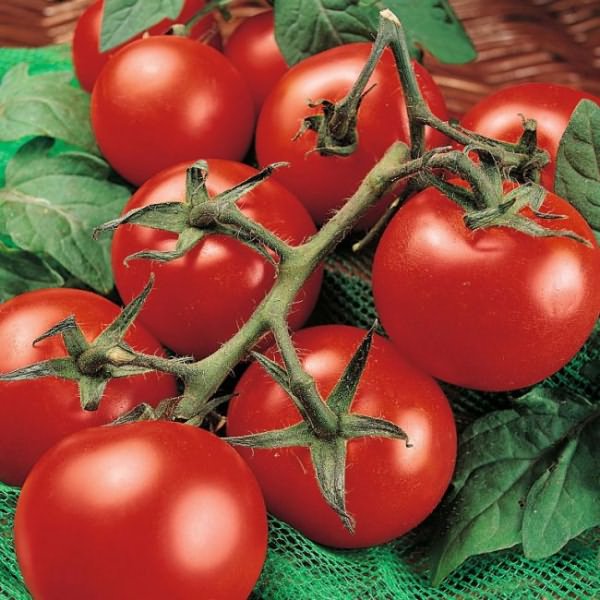
Tomato "Long Keeper"
Srednerosly plant, whose height can reach one and a half meters, shows good results in growing tomatoes in the greenhouse - up to four kilograms of fruit from the bush. This variety is intended only for greenhouses, where it should be provided with the following care - timely watering, temperature adjustment, plant formation, obligatory garter, planting pattern - no more than three plants per 1m2. The variety is late ripening, and therefore, the fruits ripen without the plant. Fruits are rather large, rounded, sometimes, weighing up to 300 g. The color of the fruit varies with ripening.
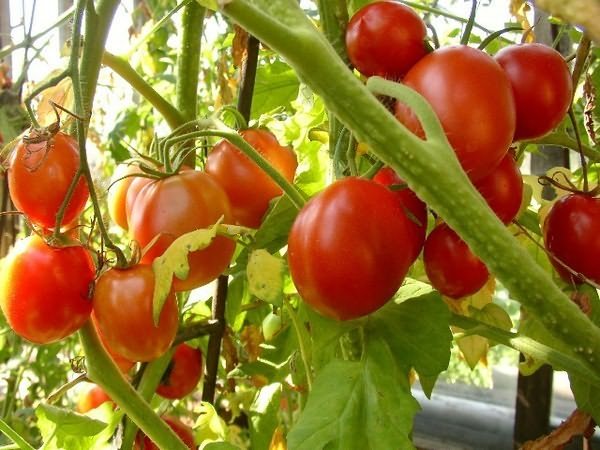
These varieties are considered very popular and in demand in the agro-industrial complex. Also, they can easily be grown in their own greenhouse in the country, and get an excellent result. We also recommend that you consider the following varieties of tomatoes for greenhouses, presented below:
Tomato "Miracle of the Earth"
Practically no flaws, but because it is very popular among summer residents. This is a variety with very sweet fruits and high yields - up to 3-4 kg from a bush. Tall, up to two meters, and early ripe variety with elongated heart-shaped fruits, sometimes up to 400-500 g in weight. There are champions who reach weights of 900 grams or more. Experts say that this variety is great for mass cultivation, for example, for business. It is drought-resistant, reacts neutrally to changes in temperature and humidity, is well stored and transportable;
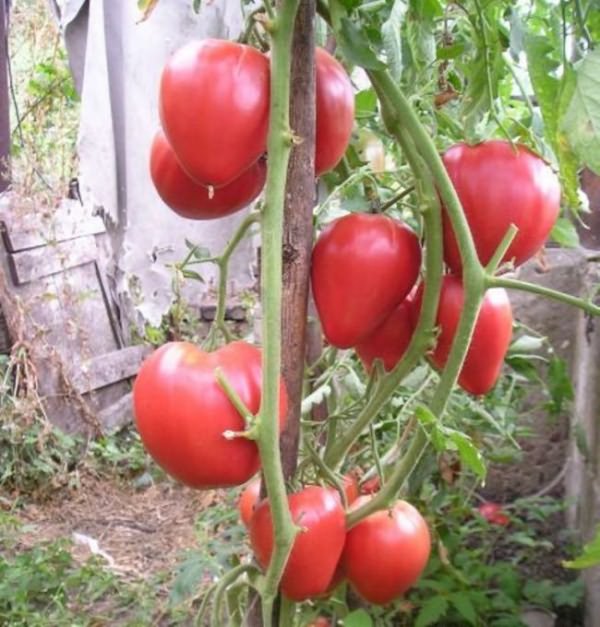
This is a variety with very sweet fruits and high yield - up to 3-4 kg from a bush.
Dina Tomato
Sredneranny and srednerosly, with a high content of carotene variety of tomatoes, which is very like the owners of greenhouses. Shrubs in height only up to 120 cm, but with an indicative yield, which reaches 4-4.5 kg of fruits from one bush. Tomatoes of this variety are small, only about 120-150 g, but good quality, rounded and smooth. The advantages are also considered to be that Dina bears fruit throughout the entire life of the bush, which, by the way, is quite resistant to drought and some diseases. Fruits of a grade remarkably are suitable for conservation and for the use in the raw state;

Bull's Heart Tomato
Classical for professional summer residents a variety of tomatoes, which surprises not only with the quality of the fruits, but also with their original appearance. The variety has a high yield, high unit weight of fruits, sometimes up to 300 g, several types of varieties that can divide tomatoes by color - yellow, red and almost black. “Tomatoes“ Bull's heart ”require special care and increased attention, only then the fruits of this variety will be large, fleshy and juicy. The main condition for growing varieties in greenhouses - garter, temperature control, watering and other modes.
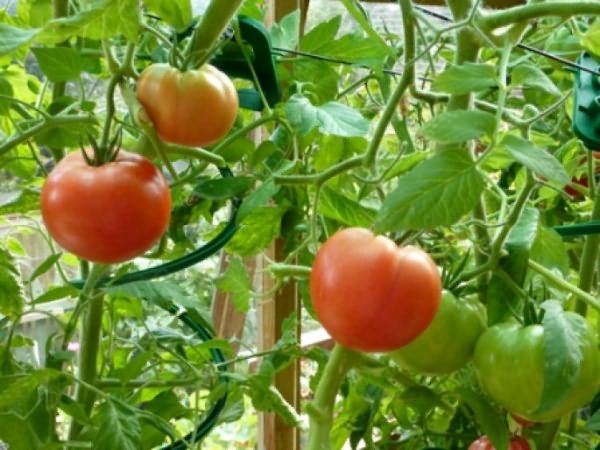
In addition to these varieties, which are described in such detail for us by various kinds of specialists, we know more than a hundred and others that can be planted in the greenhouse and show at the end of the season good harvest High Quality. Enumerate them all, we, unfortunately, are not able to, but here we can announce the names of some of them: Boney MM tomatoes, tomatoes for the greenhouse Orange, a good greenhouse variety of tomatoes French nail, and also, Weinmon, Leader 165, San Marzano, Super Marmande, Tiger tomato, Oksana.
Video about tomato varieties for the greenhouse
Naturally, it is necessary to choose tomatoes for the greenhouse not only by the pretty name and picture, their quality indicators and characteristics you like, but, first of all, by the growing conditions, which must fully correspond to one or another variety. Therefore, if you want to grow good tomatoes high quality and to choose the best varieties of tomatoes for the greenhouse, n.
I like the California miracle pepper, red and yellow. Huge. sweet.
Eggplant is white and green varieties (there are many different now), purple is not mine.
About tomatoes difficult, until top grade not found for myself. In search.
Nickname
pepper and paprika can be chilli, growth at a temperature of +18 - tyre +25 degrees, data from the directory, which is a larger-than-average tomato
Lily
Tomatoes, tomatoes, Danko, rose, dimensionless, king of Siberia, pepper-shaped. Pepper-Aladdin (colorful peppers on a bush) big ma, big dad.
Lyudmila Eremina
Pepper - Belozerka, Winnie the Pooh, Gift of Moldova. I like them first of all for being so yellow in technical ripeness. And they are fruitful and juicy.
Tomatoes - Mosk. delicacy or mosk. delicacy Super, Japanese truffle. This is a super-yielding variety. Suitable for salting and kommerch. goals. For salads, Bull heart, Masha. Plant only varieties, not hybrids. Hybrids are tough.
But the eggplant. - buy any hybrids!
From store peppers, I personally grew some sort of pipettes, not peppers!






